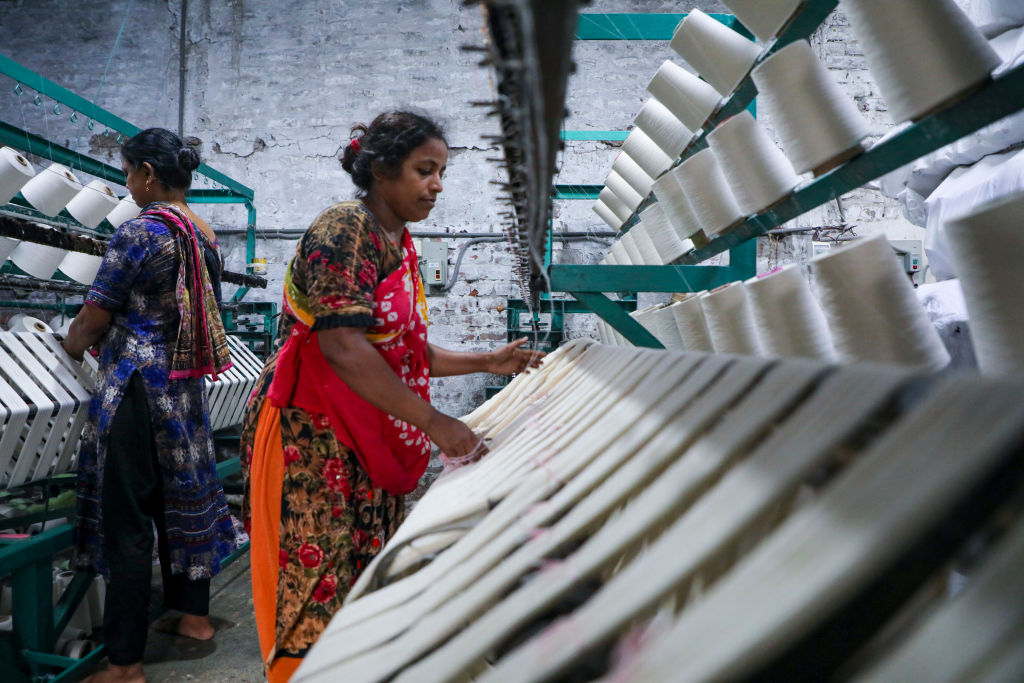Dear Capitolisters,
The Texas Rangers are in the American League Championship Series for the first time in more than a decade (and up 2-0), so there’s no better time than now for 4,500 words—plus charts—on why they’re great.
Okay, okay, just kidding. (But still: Go Rangers.)
Anyway, one of the most common criticisms of free trade and globalization is the dreaded “race to the bottom”: Open markets, so the story goes, let greedy multinational corporations invest in places with terrible labor and environmental conditions, and in turn push governments to progressively lower their regulations to attract those investments. Over time, this allegedly leads to conditions (wages, work hours, pollution, and so on) both here and abroad that are worse than they’d be without all that “free market fundamentalism”—and worse than they were just a few years prior.
The race-to-the-bottom theory became trendy—especially on the left—in the late 1990s during the last big anti-globalization push. Perhaps most famously, Nobel laureate Joseph Stiglitz said in 2002 that “globalization has become a race to the bottom, where corporations are the only winners and the rest of society, in both the developed and developing worlds, is the loser.” The narrative continues today. In fact, our very own United States trade representative, Katherine Tai, has repeatedly asserted that the race to the bottom is not just real, but a core failure of past U.S. trade policy. A few weeks ago, in fact, her office went out of its way to trumpet House Ways and Means Committee Ranking Member Richard Neal’s letter to the Wall Street Journal defending the Biden administration’s protectionist approach to trade because it supposedly avoids the “race to the bottom.”
There’s just one problem: Since those famous Stiglitz words 21 years ago, we now have reams of data showing the race-to-the-bottom thesis to be not just false, but actually counterproductive for those who truly care about helping the world’s working classes or improving the environment. In reality, global capitalism—and the economic growth, rising living standards, and technological proliferation it foments—has been pretty darn good for both the developed and developing world.
So why do so many people pretend otherwise?
Me or Your Lying Eyes?
At a superficial level, the “race-to-the-bottom” argument has never really made much sense: If most multinational corporations truly did prioritize terrible labor and environmental conditions above all else and were actually powerful (and desirous) enough to push governments to lower their standards to win or retain foreign direct investment, then least developed countries (LDCs) like Cambodia or Malawi would routinely sit atop the world’s foreign direct investment (FDI) rankings. (Spoiler: They don’t, while the United States usually does—even for manufacturing.)

Indeed, the United States routinely attracts more FDI—a lot more—than all 46 LDCs combined:

These data, of course, don’t tell the whole story, but my Cato colleague Johan Norberg has helpfully filled in the rest of it in a wonderful new essay for our ongoing project on globalization.
What Has Actually Happened to Labor Conditions?
First, Norberg shows that global labor conditions have undoubtedly improved since the 1990s, thanks in no small part to globalization. Among the data he cites:
- According to the International Labour Organization, the share of the world’s labor force in elementary and lesser‐skilled jobs (a proxy for low incomes and bad working conditions) declined by more than 10 percentage points from 1994 to 2019. Low-income countries saw a 6 point decline, while upper-middle-income countries—i.e., the ones that have most integrated into the global economy since the 1990s—saw a 20 point drop.
- The share of workers living in extreme poverty has collapsed (see Figure 1), while the share working in moderate poverty has also seen big declines (from 21 percent to about 12 percent). The biggest drops, meanwhile, were in more globalized Asia (and not just in China), while less-connected Africa saw smaller improvements.

- Child labor has seen similarly great improvements (though there is room to do better):

Second, many sources show that these gains have come in large part because of globalization, not despite it. Norberg again:
Using data from 114 countries, Andreas Bergh and Therese Nilsson found that increased globalization in a country, as measured by the KOF Globalisation Index, is associated with significantly faster poverty reduction.
In his book Globalization and Labor Conditions, Robert Flanagan summarizes the evidence: “Countries that adopt open trade policies have higher wages, greater workplace safety, more civil liberties (including workplace freedom of association), and less child labor.” Flanagan and Niny Khor also document this relationship in “Trade and the Quality of Employment: Asian and Non‐Asian Economies,” in the OECD report Policy Priorities for International Trade and Jobs.
Based on these and other studies, the Organization for Economic Cooperation and Development (OECD) concluded a few years ago:
Indeed, the worst of fears about a race to the bottom do not appear to have materialised systematically in the real world, though examples do arise. A large empirical literature seems to point, if anything, to the opposite conclusion.
Most recently, a group of economists examined in a series of National Bureau of Economic Research papers both the theoretical and empirical case for the labor “race to the bottom,” and they again found the theory lacking. In particular, their model of global value chains showed that 1) countries adopt stricter labor standards—privately or via regulation—with globalization than with autarky, “because labor standards are a normal good and the general increase in incomes from globalization increases demand for them”; and 2) when developing countries trade with richer nations (e.g., Mexico and the United States), government-set labor standards in the former are “stricter than optimal” (“optimal” here meaning perfectly efficient) because the country can pass some of the costs of its improved labor standards on to other, wealthier countries—including their consumers. In the second paper, the economists dug through data on FDI and collective bargaining rights (which isn’t necessarily the best proxy for labor conditions, but still …) and “conclude that there is no meaningful race-to-the-bottom effect in the data.” Put another way, “there is no tendency for a country with a larger increase in FDI to see a larger erosion of the labor rights.”
Real-world cases disproving the race-to-the-bottom also abound. Consider, for example, Bangladesh, which has long been one of the poorest places on the planet but has experienced several decades of expanded trade (especially in textiles and apparel), strong economic growth, and dramatic declines in poverty:

So, why did the globalization critics get this so wrong?
Well, beyond the classic “anecdote versus data” problem that plagues almost all policy analysis, race-to-the-bottom advocates ignored that labor costs and conditions are only one of many factors that multinational corporations consider when deciding where to locate. Others include infrastructure, local governance (stability, rule of law, etc.), tax and regulatory policies, materials costs and availability, and the size and quality of the local workforce. Even looking specifically at labor costs, these critics ignored the value that workers provide their employers in exchange for pay. As Norberg explains (emphasis mine):
The race‐to‐the‐bottom hypothesis got it wrong because it neglected half the cost‐benefit analysis. If labor compensation (in the broad sense, including working conditions) were just a gift generously bestowed on workers, it would make economic sense to reduce it as much as possible, but in a competitive labor market, it is compensation for the job that someone is doing, and therefore there is a tight link between pay and productivity. Some workers might be twice as well paid as others, but that does not make them uncompetitive if they are also twice as productive.
(The link between pay and productivity remains intact, by the way, but that’s a newsletter for another time.)
Thus, it’s only the least-skilled, most labor-intensive work—textiles and apparel, for example—that are at risk of wide-scale offshoring because of cheap labor or weak labor standards. For most other industries, the skill and productivity of workers in developed countries keeps them in the game—regardless of all the non-labor factors that go into investment and location decisions too.
Adherents to the race-to-the-bottom theory also make other fundamental mistakes. Most notably, they ignore that multinational corporations create entire supply chains and make big fixed-cost investments in developing countries—investments that improve local workers’ productivity, pay, and labor conditions at those firms and at local firms that have to compete for the same labor. From Norberg:
Research consistently shows that manufacturing firms pay better than other firms, export firms pay higher wages than producers for the domestic market, and foreign‐owned companies pay higher wages than comparable local companies—between 16 and 40 percent more in Africa, Asia, and Latin America. There is also a positive effect on wages in local businesses that participate in international supply chains.
As has been shown in China, India, Indonesia, Vietnam, Poland, Romania, and elsewhere, countries and workers end up moving up the value chain, into better industries and jobs, as they get wealthier—and research has consistently found that globalization helps them do that. The same goes for child labor: “As parents get better jobs, they can afford to forgo their children’s wages and instead invest in their education. One study found that a 10 percent increase in a country’s economic openness is associated with a 7 percent decrease in child labor.” Huzzah.
These trends are continuing today. As the Wall Street Journal reported in August, in fact, multinational toy, garment, and footwear manufacturers in Vietnam and other “ultra cheap” Asian locations are struggling to find workers, even after improving pay and conditions on the factory floor (one featured factory even had floor-to-ceiling windows, free yoga and dance classes, and a cafe serving matcha tea). As one expat factory-owner in Ho Chi Minh City hilariously laments, he can’t find or retain workers today because “everybody wants to be an Instagrammer or a photographer or a stylist or work at a coffee shop.”
Hey, they’re just like us!
Some of these industries will move on to other, cheaper countries (and raise wages there too), and there are surely some examples of global companies with bad labor conditions. Yet the overall picture of freer trade and development is of a race to the top, not to the bottom, for the world’s poorest workers. Indeed, when tragedy does strike these places, globalization can help there too: Attention from private watchdog groups and global media can fuel consumer backlash in developed countries that pushes companies and governments to improve local working conditions. Since the terrible 2013 Rana Plaza factory collapse in Bangladesh, for example, the global outcry and local response caused hundreds of American and European businesses to implement new safety initiatives; as a result, “tens of thousands of factory inspections have taken place; electrical upgrades, fire alarm systems, fire doors, and sprinkler systems have been installed; and building foundations have been improved.”
What About the Environment?
The story on the environment is more complicated, but eventually just as optimistic. Unlike labor conditions, countries’ early-stage urbanization and industrialization tend not to correlate with an improving environment. However, after a while, the trend reverses, and environmental conditions begin to improve as national wealth increases—whether fueled by trade or anything else. We see in the data an “environmental Kuznets curve”: Pollution and other environmental damage accompanies early stage development, but this trend flips as countries pass a certain point of development because richer populations prioritize a cleaner environment and can now afford both tighter environmental regulations and new environmental technologies:

Trade again plays a big role in this process—by helping to make countries richer and by accelerating the dissemination of technology from more advanced countries. Thus, for example, economists Jeffrey Frankel and Andrew Rose have found that increased trade “correlates with reduced air pollution, independent of the effect wealth had on environmental progress.”
As with labor conditions, there are surely exceptions to these optimistic trends, and examples of bad behavior do exist, but Norberg shows that the overall trend is positive:
The notion that countries would dismantle their environmental protection to attract investors is not correct. On the contrary, national environmental measures are tightened globally as countries get richer, albeit at different rates. Remarkably, according to the OECD’s measures, average environmental protection is now stronger in the BRIICS countries (Brazil, Russia, India, Indonesia, China, and South Africa) than it was in Sweden, the UK, the United States, and almost all other rich countries in 1995.
As the Financial Times documented earlier this year, both points—improving conditions and accelerated improvement for less-developed nations versus their more-developed peers—also apply to CO2 emissions:
Starting in the 1980s with the advent of nuclear power, it became increasingly common to see countries cutting emissions while growing GDP. The pace of this decoupling has now accelerated as the shift from carbon-intensive manufacturing to services and from dirtier to relatively cleaner fossil fuels has been supercharged by proliferating cheap renewables. In 2016, 70 countries — more than one in three worldwide — had a run of at least five years in which carbon emissions declined while GDP grew. Green growth is already here.

And, again, emerging economies are moving faster along the CO2 curve (emphasis mine):
Even putting aside the climate justice argument, there has long been an assumption that developing countries would have to go through dirty growth. But here again the data paint a promising picture. While developing countries do follow an environmental Kuznets curve, where the carbon-intensity of GDP increases before falling away again, each successive cohort traces a cleaner path than the last.

A brand new report from the San Francisco Fed finds much the same thing, with global carbon emissions intensity back to levels not seen since the 1800s, and developing countries—including big developing country emitters China, India, and Russia—improving faster:

Keeping poorer countries poor—including by blocking off trade with them—will delay (if not thwart) this great progress.
Summing It All Up
For both labor standards and the environment, the “race to the bottom” is a myth. While bad or scary things of course still happen in the world, the general, long-term trends are overwhelmingly great: Wages and working standards have improved, and have done so more quickly for countries more open to the world. Multinational corporations do sometimes invest in poor countries, and sometimes to access cheap labor, but “sweatshops” are not only better than the actual alternatives—they end up raising living standards and leading to better jobs. While countries’ initial development can create more pollution or other environmental degradation in the short term, their economic growth eventually leads to higher environmental sustainability—and does so usually faster than their rich country predecessors, thanks to free markets and the diffusion of knowledge.
This is all great news and worth cheering—something that some of the more intellectually honest lefties are indeed doing today, even if it requires admitting past errors:
But the race-to-the-bottom myth persists elsewhere, as our own USTR unfortunately keeps showing. That’s owed to a lot of things—especially the politics of trade policy and a few “seen” tragedies or other events (e.g., factory relocations) masking troves of “unseen” data and good news—but it’s no less wrong.
And the world’s poorest people are worse off for it.
Chart(s) of the Week











Please note that we at The Dispatch hold ourselves, our work, and our commenters to a higher standard than other places on the internet. We welcome comments that foster genuine debate or discussion—including comments critical of us or our work—but responses that include ad hominem attacks on fellow Dispatch members or are intended to stoke fear and anger may be moderated.
With your membership, you only have the ability to comment on The Morning Dispatch articles. Consider upgrading to join the conversation everywhere.